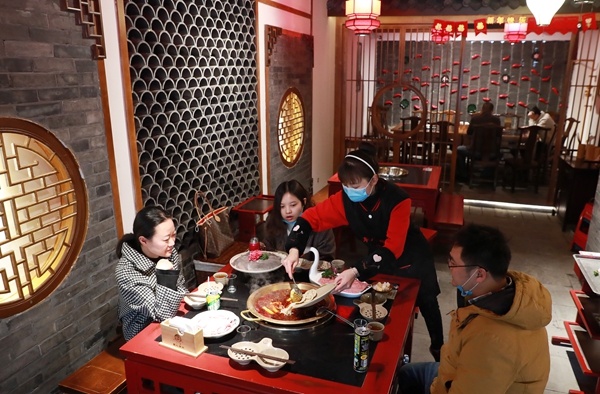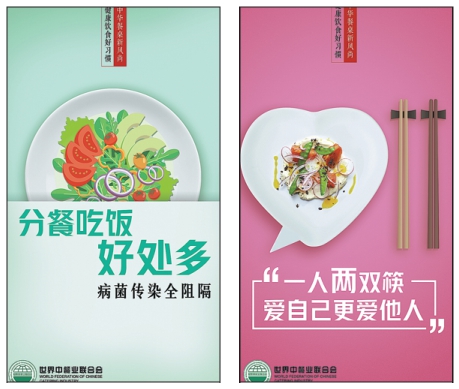
Residents enjoy hotpot at a Chengdu restaurant after it reopened recently.[Photo provided to China Daily]
A new specification details procedures for individual diners, shared dishes, and personal and serving chopsticks at restaurants, Li Yingxue reports.
The spring menu at the modern Sichuan-cuisine restaurant The Bridge in Chengdu, Sichuan province, features seasonal ingredients as always but this year, a new tweak has been added-that is, the set meals are for a single person.
All signature cold dishes, including fried cordyceps flowers and marinated shrimp with chilies, are served separately in small hexagonal boxes for each diner, as are the following 20 dishes.
The COVID-19 outbreak has challenged the deep-seated Chinese dining tradition of sharing dishes communally, causing both governments and restaurants to reimagine mealtime etiquette.
The World Federation of Chinese Catering Industry and the China Council for the Promotion of International Trade's commercial sub-council co-released a specification on individual portions, communal dishes, and serving and personal chopsticks on March 18.
The specification states that individual diners' food should be served to customers in separate tableware.
Each shared dish should be served with a separate pair of serving chopsticks.
And each diner should have two pair of differently colored chopsticks. One is to pluck dishes from communal dishes to place into individual bowls, and the other is for eating from individual bowls.
The specification was drafted based on catering specialists' opinions, the situation facing the industry in China and research on catering businesses, including restaurants and hotels, federation executive vice-president Xing Ying says.
Xing thinks that, even though catering services have changed somewhat since SARS in 2003, including improved food safety, there isn't yet consensus about healthy eating, and COVID-19 has reminded people about the issue.
The federation developed a proposal on eating separately, using serving chopsticks, and two pairs of chopsticks-one for serving on Feb 17.
Over 200 companies have since followed the guidelines.
The specification aims to protect the public health in a scientific and practical way.
China Council for the Promotion of International Trade Commercial Sub-Council secretary-general Yao Xin believes the specification is formulated in a way that should apply to both domestic catering companies and Chinese restaurants overseas.
On March 24, Shanghai's Pudong district proposed the use of serving chopsticks and spoons in restaurants, and 19 restaurants in two business areas have adopted this practice, including major hotpot chain Haidilao.
Sun Jiayi, deputy general manager of Laya Plaza in Shanghai, tells Xinhua News that customers who use serving chopsticks will get reward points they can exchange for parking coupons.

The World Federation of Chinese Catering Industry and the China Council for the Promotion of International Trade's commercial sub-council co-released a specification on individual portions, communal dishes, and serving and personal chopsticks that aims to protect the public health in a scientific and practical way.[Photo provided to China Daily]
"Sometimes the clients may confuse which pair of chopsticks is personal and which is for serving," Sun says. "It's a problem but also an opportunity for restaurants to design their own serving chopsticks that are memorable with interesting or stylish designs."
Wang Jing, a specialist at Shanghai's municipal center for disease control and prevention, tells Xinhua that it's important to make serving-chopstick use a new part of culture and fashion. This requires customers' insistence.
According to a survey about noncommunal dining by think tank Thinker, nearly 89 percent of almost 100,000 interviewees believe it's more hygienic because it reduces the risk of infection via saliva.
Respondents' three main reasons for not dining individually are tradition, which is hard to change, rapport among diners and that Chinese cuisine is typically served in shared plates and dishes are difficult to divide into individual portions. Three-quarters of respondents say they support non-communal eating.
One respondent likened it to wearing a mask to protect yourself and others. Another said that friendships weren't affected by the fact all students eat separately in a college canteen.
Wang Renxiang, a researcher at the Chinese Academy of Social Sciences' Institute of Archaeology, says the tradition of eating from shared plates dates back over a thousand years.
"We previously customarily ate separately. We find evidence for this spanning a period of at least 3,000 years."
Many historical anecdotes mention individual servings, such as Sima Qian's Records of the Grand Historian, which records the story of Lord Mengchang in the Warring States Period (475-221 BC). Every participant in his banquet is served separately.
Unearthed relics and murals in ancient tombs also indicate individual servings.
"Han Dynasty (206 BC-AD 220) tombs' murals often show people sitting on the ground and eating separately. We also see many low wooden tables with beautiful patterns," Wang says.
The low wooden dining tables are also found at the Taosi site in Shanxi province, which dates individual portions to 4,500 years ago.
Communal dining gradually developed around the Tang Dynasty (618-907), when higher tables and chairs appeared, Wang says.
The famous painting Along the River During the Qingming Festival (Qingming Shanghe Tu) shows people eating together on high tables in the Song Dynasty (960-1279).
Wang believes both customs of individual and communal dining result from history.
"Eating together encourages advanced cooking skills in Chinese cuisine," he says.
"Some gastronomes worry that eating separately may influence traditional cooking methods."
"In modern times to eat individually may lose some tradition, but it can also mean more opportunities for creating something new in Chinese cuisine."

Popular Videos
Hot comments
- First apes at U.S. zoo receive COVID-19 vaccine made for animals, zoo official says
- China Life: Chinese women shine with She Power
- Foreign firms approved to offer VPN services in capital
- Homemade curling videos trending in China
- 86-year-old grandma in Hebei spends most her life on traditional cheongsam
- Winners of 2022 Inaugural WLA Prize announced
- Lantern Festival: A romantic celebration in China
- Two Chinese COVID-19 vaccine firms to supply vaccines to COVAX
- Media center for 20th CPC national congress to open on Oct. 12
- Six suspects arrested in HK for role in SE Asia job scam
Top Reviews
- Young artists recreate beauty of traditional Hanfu costume
- China releases photos of tallest tree
- English version of ‘Understanding Xi Jinping’s Educational Philosophy’ published
- China crowned in men’s team for 10th straight time at table tennis worlds
- China publishes Atlas of Wildlife in SW China
- Guangxi’s 10 Years: A Visit to China’s Qinzhou Port
- Congress delegate helped lift village out of poverty
- Expo highlights joint efforts in NEV development
- Racism stain of shame on ‘world democratic paradise’
- U.S. may face new COVID wave this upcoming winter: report







